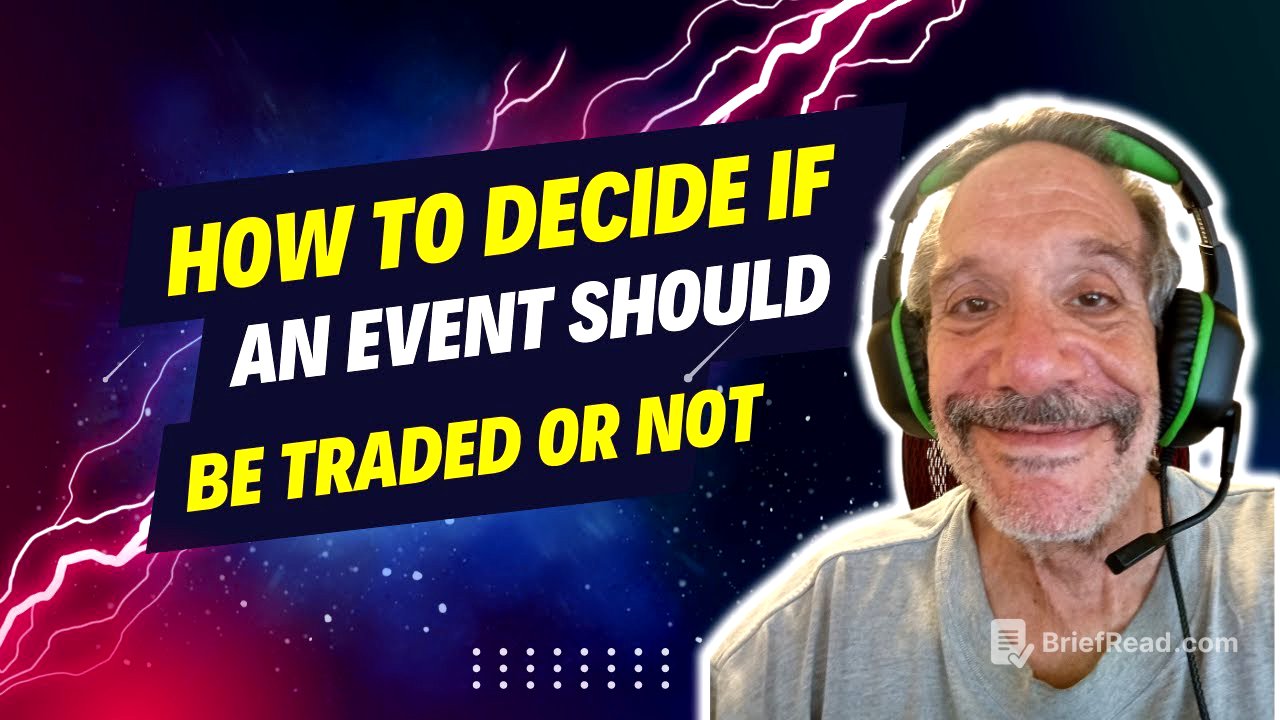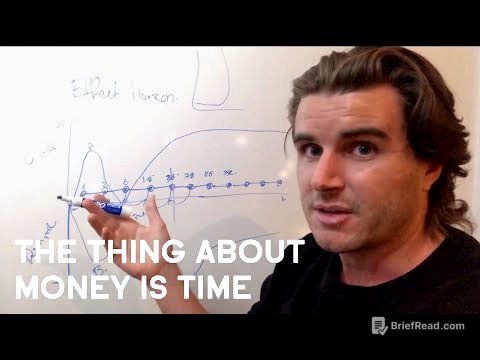TLDR;
This YouTube video provides a detailed analysis of trading strategies for the Thursday unemployment job report, with a focus on the inconsistencies and challenges associated with this particular news event. Lee Goldstein from 10 Minute Trades reviews past reports, discusses the use of micros for eval accounts, and introduces a new software feature for manual breakout trading. The video also covers reversal strategies, the importance of backtesting using NinjaTrader's replay function, and clarifies the use of time settings in different trading scenarios.
- The Thursday jobless claims report is highly inconsistent, making it difficult to trade profitably.
- Trading micros is recommended for eval accounts due to smaller drawdown limits.
- A new software feature allows for manual breakout trading with customisable levels of interest.
- Reversal strategies can be effective, especially when combined with a candle explosion technique.
- NinjaTrader's replay function is essential for backtesting and refining trading strategies.
Introduction to the Job Report Trade [0:01]
Lee Goldstein welcomes viewers to the Pro Trade Room for a discussion on trading the unemployment Thursday job report and trade balance. He reminds viewers that the trades discussed are for educational purposes and that trading Futures involves the risk of losing money, so caution is advised. He mentions the Canada trade balance, but doesn't think it's worth watching.
Challenges and Inconsistencies of Jobless Claims [1:13]
The speaker discusses the inconsistencies of the Thursday jobless claims report, noting that it's often unreliable for trading. He explains that he considered cancelling the trade room due to the report's inconsistency. He also mentions that Thursday jobless claims often coincide with other reports like CPI or PPI, making it difficult to analyse in isolation. He reviews past jobless claims reports from March 2023, noting that they were trading the ES breakout, a strategy they haven't used in a long time.
Reviewing Past Jobless Claims Reports [4:24]
The speaker reviews jobless claims reports from March 21st, February 8th, February 1st, and February 22nd, highlighting the varying degrees of success with different trading strategies. He notes that the Philly Fed report often contaminates the jobless report, making analysis trickier. He points out that some moves were tradable, while others were unsafe, and emphasises the importance of deciding whether the potential profit justifies the risk.
Analysing Trading Opportunities and Risks [8:57]
The speaker continues to analyse past reports, including one from January 17th, noting that the Philly Fed report often contaminates the jobless report. He emphasises that trading the breakout is a coin toss and not a strategy he would recommend for building an account. He also discusses the potential for fast moves and the importance of getting a good fill.
Setting Up for the Current Report [13:55]
The speaker discusses his plans for the current report, noting that he barely wants to watch the Canadian dollar trade balance. He explains that he's setting up mnq and mgc micros for his jobb and top step accounts, respectively. He also shares his thoughts on eval accounts, suggesting that many people use them for entertainment rather than serious trading.
Considerations for Eval Accounts [15:39]
The speaker emphasises that eval accounts should be treated as smaller accounts due to the drawdown limits. He recommends trading with one full-size contract or using micros, especially in the beginning, to avoid blowing up the account. He also reminds viewers to be aware of daily drawdown limits.
Trading Strategy and Setup [16:55]
The speaker outlines his trading strategy for the current report, focusing on change in direction trades with micros to limit risk. He sets up reversal trades on gold and mnq with small targets and stops, using a 30-second chart and the squeeze indicator for scalping. He also mentions that he'll be more willing to trust his analysis due to the psychology of trading micros.
Implementing Reversal and Breakout Setups [20:32]
The speaker explains that he's not focusing on breakouts due to their inconsistency. He sets up reversal trades with targets of 10 and 30 ticks and a stop of 25 ticks. He also discusses the concept of a candle explosion reversal, where you reverse a candle's direction without looking at the news. He notes that this strategy requires focusing on one chart to react quickly enough.
Introducing Manual Breakout Feature [24:01]
The speaker introduces a new software feature for manual breakout trading, allowing users to set a level of interest for entry. He sets up a manual breakout trade on the NQ in Sim, explaining how the feature works. When enabled, the software will trigger a trade if the market bursts to the specified level. He clarifies that the gold trade reversal is manual, using buttons, and doesn't require a time setting.
Adjusting Levels and Waiting for the News [27:29]
The speaker discusses adjusting the levels for the manual breakout trade, considering the vwap and potential whipsaws. He sets levels for both the top and bottom, anticipating potential bursts in either direction. He then waits for the news to be released, watching for a reaction and preparing to let the software test the set levels.
Post-News Analysis and Trade Cancellation [29:49]
The speaker observes that there's not a big response to the news and that neither of their levels were hit. He considers whether to let the orders fill based on the news analysis, which suggests a continuation to the upside. Ultimately, he decides to cancel the NQ and micro gold orders because nothing significant happened.
Replay and Backtesting with NinjaTrader [32:29]
The speaker decides to run a replay of the trade to analyse what happened and to help a viewer understand a reversal trade. He demonstrates how to download historical data and disconnect from live connections to use NinjaTrader's playback feature. He emphasises that replay is the most important feature for testing strategies and practicing trade management.
Setting Up Replay and Breakout Strategy [35:38]
The speaker sets up the replay with the correct date and time, ensuring the software can calculate properly. He focuses on analysing what full-size gold did on the report and whether there was an opportunity for a reversal. He then adds a breakout strategy to the chart, setting the parameters and saving it as a template for future use.
Analysing Gold Breakout and Reversal [38:58]
The speaker plays back the gold market action, observing that the breakout was definitely tradable for Target one. He then goes back to the beginning of the trade to look for a change in direction, setting up a reversal strategy with a target of 15 ticks and a risk of 20 ticks. He emphasises that you can have both breakout and reversal trades ready, but not run them simultaneously.
Executing and Analysing Reversal Trade [41:53]
The speaker explains that an area of interest for a reversal would be the PP. He then executes a short reversal trade on the candle pop, moving his stop above the PP. He describes it as a mediocre candle explosion trade and explains how the reversal strategy can be used any time of day, in any scenario, with pre-set stops and targets.
Analysing NQ and Breakout Strategy [45:10]
The speaker shifts focus to the NQ, setting up the chart and strategy for analysis. He establishes a breakout strategy with specific targets and a stop, saving it for future use. He expresses more interest in the reversal strategy for the NQ, aiming for 25 ticks with a risk of 25 ticks.
Implementing NQ Reversal and Breakout [47:50]
The speaker details the settings for the NQ reversal trade, emphasising the importance of being on a playback account. He clarifies that enabling the reversal trade puts the buttons on the screen, allowing for instant long or short market orders. He then plays back the NQ action, executing a short trade and managing the stop.
Clarifying Reversal Trade Mechanics [50:05]
The speaker addresses a viewer's confusion about the reversal trade mechanics, reiterating that the buttons appear when the reversal trade is enabled and that time is not a factor. He clarifies that it's a separate trade type from a breakout. He then briefly looks at the breakout, noting that it appeared to be a good move.
Exploring Break-Even and Trailing Stops [53:36]
The speaker answers a question about when to use the Target One Stop move, explaining that it's useful in whippy trades to protect profits. He also discusses the use of trailing stops, demonstrating how to turn them on and explaining that they move the stop automatically. He runs the same breakout with trailing on, noting that it's a feature they should use more often.
Final Thoughts and Q&A [59:01]
The speaker summarises how to use the reversal strategy, emphasising that the buttons appear when the strategy is enabled in the control panel. He answers further questions about time settings and clarifies that time is ignored in reversal trades. He directs viewers to a video on market playback for more information and concludes the session, announcing the next session on natural gas.









